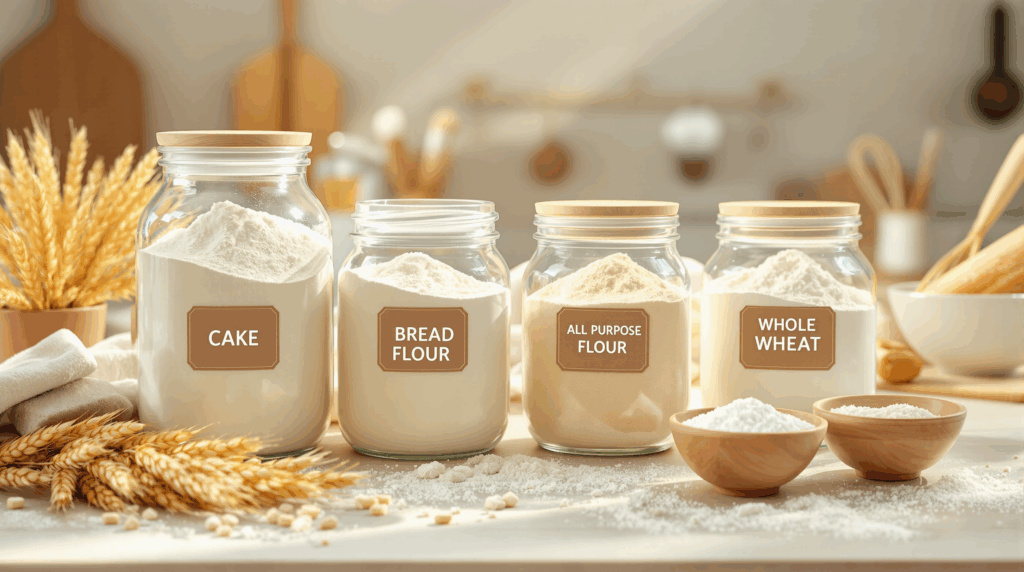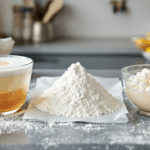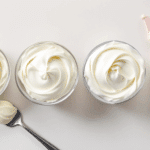Welcome, aspiring baker! You’re ready to transform simple ingredients into delicious creations. But before you dive in, let’s talk about the foundation of most baked goods: flour. Think of it as your culinary canvas – the type you choose fundamentally dictates the texture, structure, and even flavor of your final product.
Walking down the baking aisle reveals a dizzying array – all-purpose, bread, cake, pastry, whole wheat, gluten-free blends. This variety isn’t arbitrary; each flour has unique characteristics. Understanding these differences is practical power. It means achieving a light cake versus a tough one, a crusty loaf versus a dense brick. For anyone dreaming of becoming a baker, mastering flour is essential. This guide will demystify flour types, explain the science, and help you confidently select the perfect one for every bake.
Understanding Flour Fundamentals
At its core, flour is powder ground from grains, roots, nuts, or seeds. In traditional baking, “flour” usually means wheat flour. Wheat’s magic lies in proteins that form gluten when mixed with water.
The Magic of Gluten: Gluten, formed from wheat proteins gliadin (stretchiness) and glutenin (strength, elasticity), creates a web-like network in doughs and batters. This network:
- Traps Gases: Captures CO2 from yeast or leaveners, causing rising. Stronger gluten holds more gas.
- Provides Structure: Sets during baking, forming the crumb structure and preventing collapse.
- Influences Texture: Strong gluten = chewiness (bread); weak gluten = tenderness (cake).
The protein percentage in wheat flour is the key differentiator. More protein means more potential gluten (stronger results); less protein means less potential gluten (tender results).
Key Flour Terminology:
- Extraction Rate: Percentage of the original grain kernel (bran, germ, endosperm) remaining. Whole wheat is 100%; white flour (mostly endosperm) is lower (e.g., 70-80%).
- Bleached vs. Unbleached: Freshly milled white flour is yellowish. Natural aging whitens it (unbleached). Chemical bleaching (using agents like benzoyl peroxide or chlorine) speeds this up, potentially weakening gluten slightly and altering absorbency. Chlorine bleaching (often for cake flour) helps starch absorb more liquid. Many prefer unbleached for flavor and gluten strength.
- Enriched: White flour often has vitamins (thiamin, riboflavin, niacin, folic acid) and iron added back to replace nutrients lost when removing bran and germ.
- Ash Content: Measures mineral content (concentrated in bran/germ), indicating the extraction rate. Higher ash = less refined flour. Used more in European flour classifications (e.g., T55).
Understanding protein and gluten is crucial for choosing the right flour and predicting baking outcomes.
The Wheat Flour Spectrum: From Low to High Protein
Let’s explore common wheat flours, ordered by typical protein content (ranges can vary by brand/region).
1. Cake Flour (Lowest Protein: ~6-8%)
- Characteristics: Milled from soft wheat; exceptionally fine, silky texture. Almost always bleached with chlorine, which weakens gluten further and modifies starches for moisture absorption.
- Gluten Potential: Minimal; creates a very weak structure for maximum tenderness.
- Best Uses: Angel food cake, chiffon cake, sponge cake, high-ratio white/yellow cakes, some delicate cookies where tenderness is key.
- Avoid For: Yeast breads, pizza, bagels – results would be gummy and lack structure.
- Substitution: For 1 cup AP flour needed, remove 2 Tbsp AP flour and replace with 2 Tbsp cornstarch. Whisk or sift thoroughly. (Not perfect, but workable).
2. Pastry Flour (Low Protein: ~8-9%)
- Characteristics: Milled from soft wheat, slightly more protein than cake flour. Fine, soft texture, often unbleached.
- Gluten Potential: Low, but enough for some structure and elasticity needed for flaky layers while remaining tender.
- Best Uses: Pie crusts (excellent flakiness/tenderness), tarts, quiches, scones, biscuits, tender muffins, shortbread, some cookies.
- Avoid For: Most yeast breads requiring significant chew.
- Comparison: Offers more structure than cake flour (better for roll-out crusts) but more tenderness than AP flour.
3. All-Purpose Flour (Mid-Range Protein: ~10-12%)
- Characteristics: The pantry workhorse, usually a blend of hard and soft wheats for versatility. Texture is mid-range. Available bleached or unbleached. Note: Protein varies regionally; Southern US AP flour (~9-10.5%) is softer than Northern/Canadian AP flour (~11-12%+). This difference impacts results.
- Gluten Potential: Moderate; supports softer yeast breads/rolls, suitable for many cookies/cakes but won’t yield extreme tenderness or maximum chew.
- Best Uses: Most cookies, quick breads (banana, zucchini), muffins, pancakes, waffles, many cakes (chocolate, carrot), softer yeast breads/rolls, some pizza doughs, biscuits, thickening sauces.
- Avoid For: Recipes needing extreme tenderness (use cake flour) or significant chew/structure (use bread flour).
- Bleached vs. Unbleached: Unbleached is generally preferred for better flavor and slightly stronger gluten, unless a recipe specifically benefits from bleached (rare).
4. Bread Flour (High Protein: ~12-14%)
- Characteristics: Milled from hard wheat varieties; feels slightly coarser than AP flour. Usually unbleached. May contain ascorbic acid or malted barley flour to aid yeast.
- Gluten Potential: High; forms a strong, elastic network essential for trapping fermentation gases and providing structure and chew.
- Best Uses: Artisan breads (sourdough, baguettes), sandwich loaves, dinner rolls, pizza dough (essential for chew), bagels, pretzels, focaccia, cinnamon rolls.
- Avoid For: Delicate cakes, tender pastries, flaky pie crusts – results will be tough and rubbery.
5. High-Gluten Flour (Very High Protein: ~14-15%+)
- Characteristics: Highest protein content, milled from specific hard wheats, often boosted with added vital wheat gluten.
- Gluten Potential: Extremely strong and elastic.
- Best Uses: Primarily for bagels (authentic dense chew), some traditional pizza crusts (e.g., NY style). Sometimes used by professionals in small amounts to boost weaker flours.
- Avoid For: Most other baking; results in excessive toughness.
6. Whole Wheat Flour (Variable Protein: ~13-14%, Behaves Differently)
- Characteristics: Ground from the entire wheat kernel (bran, germ, endosperm). Coarser texture, nuttier flavor, brownish color. Bran/germ absorb more liquid (recipes often need more hydration) and interfere with gluten development.
- Gluten Potential: High protein content, but the bran particles cut gluten strands, and germ oils slightly weaken them. Results in denser, heavier baked goods than white flour of similar protein.
- Best Uses: Whole wheat breads (often blended 50/50 with white bread flour for better rise/texture), hearty muffins/scones/quick breads, pancakes/waffles.
- Important Notes: Requires higher hydration. Store refrigerated or frozen in airtight containers due to oils in the germ going rancid quickly; use within 1-3 months (fridge) or longer (freezer). Smell before use!
- White Whole Wheat Flour: Milled from white wheat; whole grain but lighter color and milder flavor than traditional (red) whole wheat.
Beyond Wheat: Exploring Alternative Flours
Expand your horizons with flours milled from other sources, essential for gluten-free baking or unique flavors/textures.
- Rye Flour: Distinctive earthy flavor. Proteins differ from wheat, making doughs sticky. Weaker gluten. Used for rye/pumpernickel breads, often blended with wheat flour. Comes in light to dark varieties.
- Spelt Flour: Ancient wheat relative, nutty/sweet flavor. Gluten is fragile, easily overmixed. Often substitutable 1:1 for whole wheat. Available whole or light/white.
- Buckwheat Flour: Gluten-free seed with assertive earthy flavor. Used in blini, galettes, soba noodles; often blended in baking.
- Rice Flour: Gluten-free staple. White (neutral) or brown (nuttier). Sweet rice flour (sticky rice) is chewy, used in mochi and as a GF binder.
- Nut Flours (Almond, etc.): Gluten-free, add moisture, rich flavor, density. Almond flour is key for macarons, financiers, many GF/low-carb items.
- Oat Flour: Mild, slightly sweet flavor, adds tenderness. Use certified GF if needed. Great in cookies, muffins, quick breads. Easily made by grinding rolled oats.
- Corn Flour/Meal/Masa Harina: Gluten-free, sweet flavor. Corn flour is fine, cornmeal is coarser. Used in cornbread, muffins. Masa harina (nixtamalized corn) is for tortillas/tamales. (Corn Flour ≠ Cornstarch).
- Other GF Flours: Chickpea, coconut, sorghum, teff, millet, cassava, etc., offer unique properties, often used in GF blends.
- Gluten-Free (GF) All-Purpose Blends: Combine multiple GF flours and starches with binders (like xanthan gum) to mimic wheat flour. Convenient for substituting in standard recipes (results vary).
Making the Right Choice: Matching Flour to Function
Choose flour based on the desired outcome:
- Identify Baked Good: (e.g., Cake, Bread, Pie Crust, Cookie).
- Define Desired Texture:
- Tenderness/Lightness: Need low protein (Cake Flour).
- Chewiness/Strength: Need high protein (Bread Flour, possibly High-Gluten).
- Flakiness: Need low-moderate protein, tenderness (Pastry Flour, lower-protein AP).
- Crispness: Varies, technique matters.
- Density/Heartiness: Whole grains or lower-gluten flours.
- Select Flour: Match the need to the flour type (Cake, Pastry, AP, Bread, High-Gluten, Whole Wheat, GF options).
Remember: Well-written recipes usually specify the flour type. Deviating changes the result. Brand consistency also helps ensure predictable outcomes, especially with AP flour due to regional protein variations.
Tips for Aspiring Bakers: Flour Power in Practice
Handling flour correctly is as important as selecting it.
- Respect the Recipe: Use the specified flour type unless you understand the impact of substitution.
- Measure Accurately – WEIGH YOUR FLOUR! This is paramount. Volume (cups) is inconsistent; flour compacts differently. A digital kitchen scale ensures precision in grams or ounces, leading to consistent results. This is the single biggest improvement most beginners can make.
- Store Flour Properly:
- White Flours: Airtight container, cool, dark, dry place (6-12 months).
- Whole Grain Flours: Airtight container, refrigerator (1-3 months) or freezer (6+ months) due to oils in the germ. Smell before use!
- Sifting: Generally needed only for very delicate cakes (aeration) or to evenly combine fine dry ingredients (leaveners, spices, cocoa). Whisking dry ingredients together is usually sufficient otherwise.
- Understand Substitutions: Know the likely impact (e.g., using AP instead of bread flour = less chew/rise; using bread flour for cake = tough).
- Observe and Learn: Pay attention to how different doughs and batters look and feel. Develop baking intuition through hands-on experience.
Conclusion: Your Baking Foundation Is Built on Flour
Flour, seemingly simple, is a complex and powerful ingredient – the skeleton, canvas, and substance of your baked creations. Understanding the role of protein and gluten, and the unique characteristics of Cake, Pastry, All-Purpose, Bread, Whole Wheat, and alternative flours, gives you fundamental control over your baking.
Approach the baking aisle with confidence, knowing which flour holds the key to your desired outcome. Master the core types, prioritize accurate measurement (use a scale!), store flour correctly, and learn through observation. This foundational knowledge is a crucial step on your journey to becoming the skilled, intuitive, and successful baker you aspire to be. Embrace the learning and unleash your Flour Power!







